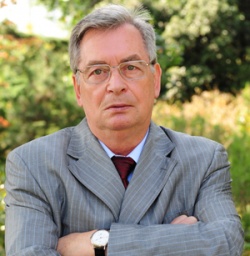President
Congress President

Prof. Vsevolod A. Tkachuk, DSc
Academician of Russian Academy of Science
Professor of Biochemistry at Lomonosov Moscow State University, School of medicine
President of the Congress together with the Presidium headed by Academician G.T. Sukhikh, the Programme and Organising Committees cordially invite leading Russian and foreign scientists to share advances and experience in the practical application of regenerative medicine.
Academic appointments
Lomonosov Moscow State University:
Head of Department of Biochemistry and molecular medicine at School of Medicine (since 1992)
School of Medicine, Dean (since 2000)
Director of Institute of regenerative medicine (since 2016)
Administrative appointments
President of National society for regenerative medicine (since 2015)
Russian Ministry of Health:
Chairman of Regenerative Medicine Expert Council
Head of “Regenerative Medicine” scientific platform
Head of “Future Medicine” technological platform
Honors & Awards
Award of Russian Federation Government in Education (twice)
Order of Honor (2005)
1st degree Award from Lomonosov Moscow State University for the series of works «Molecular mechanisms of growth and vascular remodeling» (2006)
Order of Friendship (2012)
Academician V.A. Tkachuk headed the National Society for Regenerative Medicine (NSRM) in December 2015 after the elections held during the II National Congress of Regenerative Medicine, replacing Academician G.T. Sukhih, the founder and former President of the Society, .
Since the 2000s, V.A. Tkachuk has been making significant effort into the development of regenerative medicine and the implementation of the new cellular technologies. With his active participation as an expert, the Federal Law No. 180 "Biomedical Cellular Products Act" was developed, which was later signed by President of the Russian Federation and came into force on January 1, 2017.
In addition, there were over 20 projects successfully completed under the leadership of V.A. Tkachuk together with the leading research groups. These studies include research, applied, and preclinical projects within the field of regenerative medicine, which allowed to step closer to biomedical cellular and gene therapy products for tissue renewal, vascular growth stimulation and regeneration.
Moreover, there were organised five National Russian "Stem Cells and Regenerative Medicine" conferences under the leadership of V.Tkachuk. In addition, Academician V.A. Tkachuk is the head of several state and professional bodies, i.e. Regenerative Medicine Expert Council at the Ministry of Health, the Scientific Platform "Regenerative Medicine" of the Ministry of Health, and the Technology Platform "Future Medicine".
In 2016, V.A. Tkachuk was appointed Director of the brand new Institute of Regenerative Medicine (IRM) at Lomonosov Moscow University, where he heads one of the leading scientific schools in stem cell biology, gene therapy and regenerative medicine. V.A. Tkachuk pays considerable attention to the development of education and technology within Lomonosov Moscow University and NSRM, which are mandatory for the specialist training in regenerative medicine and cell therapy, particularly in aspects of development, production, and expertise of advanced therapy medicinal products.
Scientific interest
Prof. Tkachuk's scientific interest include aspects of intracellular signaling mechanisms and hormonal regulation. Prof. Tkachuk directs active research on the mechanisms of physiological renewal, tissue and organ regeneration and reparation, as well as the role of mesenchyme stem cells (MSC) of various tissues in this process. It was discovered that MSC are able to induce growth of blood vessels and nerves during recovery of damaged tissues. Also, there was revealed the fact that apart from soluble proteins secretion, i.e. growth factors, cytokines and chemokines, the stimulatory effect of these cells is caused also by the secretion of extracellular vesicles. Besides the ascertainment of the mechanisms, which underpin MSC’s effects on tissue regeneration and reparation, active research was conducted on the hypoxia and inflammation effects on biological activity of this kind of cells. It was discovered that production of angiogenic factors by MSC is activated under hypoxic condition, moreover, these cells produce immunomodulatory cytokines, including immunosuppressive ones, under the inflammation. The results of this research revealed new approaches for therapy of infection and systemic diseases, as well as organ and tissue transplantation. Based on fundamental research conducted by prof. Tkachuk, a range of gene therapy drugs was developed. These drugs are designed to stimulate blood vessel growth and peripheral nerves recovery after an injury.
Featured papers
V. Stepanova, P. Jayaraman, S. Zaitsev, T. Lebedeva, K. Bdeir, R. Kershaw, K. Holman, Y. Parfyonova, E. Semina, I. Beloglazova, V. Tkachuk, D. Cines // Urokinase-type plasminogen activator (uPA) promotes angiogenesis by attenuating Proline-rich homeodomain protein (PRH) transcription factor activity and de-repressing vascular endothelial growth factor (VEGF) receptor expression // (2016) Journal of Biological Chemistry, 291, № 29, 15029-15045, doi: 10.1074/jbc.M115.678490
T. Lopatina, N. Kalinina, M. Karagyaur, D. Stambolsky, K. Rubina, A. Revischin, G. Pavlova, Y. Parfyonova, V. Tkachuk // Adipose-derived stem cells stimulate regeneration of peripheral nerves: BDNF secreted by these cells promotes nerve healing and axon growth De Novo // (2011) PLoS ONE http://dx.doi.org/10.1371/journal.pone.0017899
V. Stepanova, T. Lebedeva, A. Kuo, S. Yarovoi, S. Tkachuk, S. Zaitsev, K. Bdeir, I. Dumler, M. Marks, Y. Parfyonova, V. Tkachuk, A. Higazi, D. Cines // Nuclear translocation of urokinase-type plasminogen activator. // (2008) Blood; 112, № 1, 100-110, doi: 10.1182/blood-2007-07-104455
D. Traktuev, Z. Tsokolaeva, A. Shevelev, K. Talitskiy, V. Stepanova, B. Johnstone, T. Rahmat-Zade, A. Kapustin, V. Tkachuk, K. March // Urokinase gene transfer augments angiogenesis in ischemic skeletal and myocardial muscle // (2007) Molecular Therapy, 15, № 11, 1939-1946, doi: 10.1038/sj.mt.6300262
K. Rubina, E. Talovskaya, V. Cherenkov, D. Ivanov, D. Stambolsky, T. Storozhevikh, V. Pinelis, A. Shevelev, Y. Parfyonova, T. Resink, P. Erne, V. Tkachuk // LDL induces intracellular signalling and cell migration via atypical LDL-binding protein T-cadherin // (2005) Molecular and Cellular Biochemistry; 273, № 1, 33–41 doi: 10.1007/s11010-005-0250-5
A. Bobik, V. Tkachuk // Metalloproteinases and plasminogen activators in vessel remodeling // (2003) Current Hypertension Reports; 5, №6, 466-472, doi: 10.1007/s11906-003-0054-5
O. Plekhanova, M. Solomatina, A. Bobik, V. Tkachuk, V. Naumov, Y. Parfyonova // Contrasting effects of urokinase- and tissue-type plasminogen activator on vessel remodeling // (2001) Journal of Molecular and Cellular Cardiology; 33, № 6, A 95 doi: http://dx.doi.org/10.1016/S0022-2828(01)90378-5
S. Mukhina, V. Stepanova, D. Traktouev, A. Poliakov, R. Beabealashvilly, Y. Gursky, M. Minashkin, A Shevelev, V Tkachuk // The chemotactic action of urokinase on smooth muscle cells is dependent on its kringle domain. Characterization of interactions and contribution to chemotaxis // (2000) Journal of Biological Chemistry; 275, № 22, 16450-16458 doi: 10.1074/jbc.M909080199
Y. Kuzmenko, D. Stambolsky, F. Kern, V. Bochkov, V. Tkachuk, T. Resink // Characteristics of smooth muscle cell lipoprotein binding proteins (p105/p130) as T-cadherin and regulation by positive and negative growth regulators // (1998) Biochemical and Biophysical Research Communications; 246, № 2, 489-494, doi: 10.1006/bbrc.1998.8645
V. Tkachuk, Y. Kuzmenko, T. Resink, D. Stambolsky, V. Bochkov // Atypical low-density lipoprotein binding site that may mediate lipoprotein-induced signal transduction // (1994) Molecular Pharmacology; 46, № 6 1129-1137
C. Neylon, P. Avdonin, R. Dilley, M. Larsen, V. Tkachuk, A. Bobik // Different electrical responses to vasoactive agonists in morphologically distinct smooth-muscle cell-types // (1994) Circulation research; 75, № 4, 733-741


